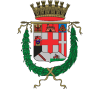In 1419 the Scuola was established in the immediate vicinity of Padua’s most important hospital – San Francesco Grande – whilst work continued on completing the construction of that hospital itself and the nearby church and monastery dell’Osservanza [the Trappists were known as “the Order of Cistercians of the Strict Observance”]. That work was financed by the rich couple of Baldo Bonafari da Piombino and Sibilla de Cetto, who lived in the house opposite the Hospital, where later the present Scuola itself would be installed. In converting the building for use by the Confraternity, new windows were opened up and a splendid coffer-beam ceiling was installed. The walls of the chamber were also decorated with frescoes of the main scenes from the Life of the Virgin.
Previously, those walls had been decorated by an unknown artist who had painted a total of fifteen panels, which were restored in 1530 by Giovanni Dal Santo; traces of the old painted decoration can be seen in the decorative band beneath the portraits of Bonafari and his wife. Then, in 1579, they were decorated with frescoes by Dario Varatori, father of the artist who became known as ‘Il Padovanino’. These sixteenth-century Scenes from the Life of the Virgin are the last great cycle of frescoes painted in Padua. There are a total of twelve scenes, with a thirteenth panel depicting Baldo Bonafari and Sibilla de Cetto.
- DISCOVER
- LIVE
FOCUS
- GET INSPIRED
FOCUS
- INFO
- BOOK NOW












